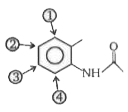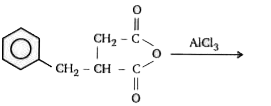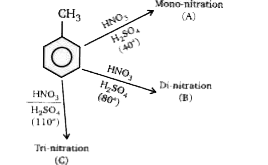Complete Solutions to LEVEL-1 of chapter AROMATIC COMPOUNDS of Class 12 book with complete answers and questions
| Class 12 | CHEMISTRY |
| Chapter | AROMATIC COMPOUNDS |
| MS CHOUHAN | LEVEL-1 |
| Number Of Questions | 100 |
| Academic Year | 2023-24 |

Identify the position where electrophillic aromatic substitution (EAS) is most faourable .
View Solution
Correct order of rate of EAS (electrophillic aromatic substitution) is :
View Solution
Above (C-N) coupling reaction take place at:
View SolutionWhich of the following has the lowest heat of combustion?
View SolutionThe product obtained from the reaction is

View Solution
The end product (C ) is :
View SolutionHow many benzylic hydrogen are present in hydrocarbon given below.

View SolutionThe major product formed in the reaction is :

View SolutionThe major product formed in the reaction is :

View SolutionIncreasing order of rate of reaction with `HNO_3//H_2SO_4` is :

View SolutionIncreasing order of rate of reaction with `Br_2//AlCl_3` is :

View SolutionIncreasing order of equilbrium constant for the formation of a hydrate is :

View SolutionRank the following reaction A, B and C in order of increasing rate,

View SolutionRank in order of increasing rate of reaction towards EAS with bromine in the presence of `FeBr_3`

View Solution
Identify the position where E.A.S. can take place.
View Solution
Product (B) in the above reactions is:
View Solution Sulphonation is most favourable at the carbon number....
Sulphonation is most favourable at the carbon number....
View SolutionArrange the following in decreasing order of reactivity towards EAS (electrophilic aromatic substitution)

View Solution
Decreasing order of rate of electrophilic aromatic substitution is : (
View SolutionArrange the following in increasing order of rate of Nitration:

View Solution
The rate of nitration will be:
View SolutionThe major product of the reaction is

View SolutionArrange in their decreasing order of rate of electrophilic aromatic substitution :

View Solution
Product (A) of the given reaction is :
View SolutionIn which of the following compound electrophilic aromatic substitution take place in phenyl ring present in left hand side ?
View Solution , Reactant (A) is :
, Reactant (A) is :
View SolutionWhich of the following compounds is the slowest to react with nitrosonium ion `(NO^+)` ?
View SolutionComplete the following reaction

View Solution
What is the major product of above Friedel-Craft reaction ?
View SolutionWhat combination of acid chloride or anhydride and arene would you choose to prepare given compound ?

View SolutionIn the given conversion best yield will obtained with :

View SolutionRank the following in order of decreasing rate of reaction with alkoxide ion `(CH_3CH_20O^-)` in a nucleophilic aromatic substitution reaction :

View SolutionIdentify the principal organic product of the following reaction.

View SolutionWhich position will be attacked most rapidly by the nitronium ion `(-NO_2)^+` when the compound undergoes nitration with `HNO_3//H_2SO_4` :

View Solution
Product (Y) of this reaction is :
View SolutionAll the hydrocarbons shown are very weak acids. One, however, is far more acidic than the others. Which one is the strongest acid ?
View Solution
Product (D) in above sequence is :
View SolutionThe action of bromine water (excess) on salicylic acid results in the formation of :
View SolutionWhat is the correct order of o/p ratio when `E^+` attacks the following system ?
A- PhF , B-PhCl, C-PhBr, D-Phl
View SolutionHow many products are capable of beings formed from toluene in each of following reaction ?

View SolutionNitration takes place at the which position of the given compound ?

View Solution
Indentify the product.
View Solution
Unknown (A) is :
View Solution
Product (C) is:
View SolutionThe reaction of toluene with chlorine in the presence of light gives :
View Solution
Product (B) in this reaction is :
View Solution Suitable product of this reaction is :
Suitable product of this reaction is :
View Solution Product (A) of the reaction is :
Product (A) of the reaction is :
View Solution Product (B) in this reaction is :
Product (B) in this reaction is :
View Solution Product (A) in this reaction is :
Product (A) in this reaction is :
View Solution Product (B) of this reaction is :
Product (B) of this reaction is :
View Solution
Product (A) of the above reaction is :
View Solution Major product (x) in this reaction is :
Major product (x) in this reaction is :
View Solution van't-Hoff factor (i) for this reaction is :
van't-Hoff factor (i) for this reaction is :
View Solution the missing reagent is :
the missing reagent is :
View Solution
above reaction is an example of Nucleophilic aromatic substitution. Which of the following halide (-X) is most readily replaced.
View SolutionWhen comparing the hydrogenation of benzene with that of a hypothetical 1, 3, 5-cyclohexatriene, benzene _____than the cyclohexatriene.
View SolutionWhich of the following hydrogens is most easily abstracted on reaction with bromine free radicals, `Br^+` ?

View SolutionThe electrophilic aromatic substitution proceeds through a
View SolutionWhich of the following substitution of benzene is ortho-para in electrophilic substitution and ortho-para in nucleophilic substitution ?
View SolutionThe number of possible isomers of dichloronitrobenzene is :
View SolutionWhich of the following is not an aromatic compound ?
View SolutionConsider the following sequence of reactions.

The end product (B) is:
View Solution`Ph - NO_2 + Et - Cl overset(AlCl_3)(to) (A)` , Product (A) of the given reaction is :
View SolutionIn nitration of benzene by mixed acid the rate of reaction will be :
View Solution Product (B) is :
Product (B) is :
View SolutionWhich of the following ring compounds obeys Huckel's rule ?
View SolutionNitration of which of the following reactant gives maximum % of meta product (using `HNO_3//H_2SO_4` ) ?
View Solution compound (x) will be :
compound (x) will be :
View Solution
Which of the following is true statement about the reaction ?
View SolutionTwo benzyne intermediates are likely to be formed equally. Reaction with amide ion can occur in two different directions with each benzyne, giving three possible products. They are formed in a 1:2:1 ratio. Asterisk (*) refers to `""^14 C` .
 Product major, product (A) is :
Product major, product (A) is :
View SolutionWhich one of the following undergoes nucleophilic aromatic substitution at the fastest rate ?
View SolutionFor the reaction,
 , the best combination of reactants is :
, the best combination of reactants is :
View SolutionThe function of anhydrous `AlCl_(3)` in the Friedel-Crafts reaction is to
View Solutionn - Butyl benzene on oxidation with `KMnO_(4)` gives
View SolutionWhich sequence of steps describes the best synthesis of 2-phenylpropene ?

View SolutionWhat are the products of the following reaction ?

View SolutionWhat is the product obtained by heating the following allylic ether of phenol ?

View SolutionWhen you ingest aspirin, it passes through your stomach, which has an acidic pH, before traveling through the basic environment of your intestine. Provide the structure form as it exists in the intestine.
View SolutionWhich of the following sets of reagents, used in the order shown, would be enable for the preparation of p-chlorophenol from p-chloronitrobenzene ?
View SolutionWhich one of the following compounds undergoes bromination of its aromatic ring (electrophilic aromatic substitution) at the fastest rate ?
View Solution Product (Q) in this reaction is :
Product (Q) in this reaction is :
View Solution
The product (P) will be :
View Solution
Product (A) is :
View Solution
This reaction is example of :
View SolutionTotal number of possible Trimethyl benzene is `:`
View SolutionCaliene, `C_7 H_6` , is expected to be a fairly polar aromatic molecule. Which of the following resonance forms contributes to the greatest extent towards the real structure (resonance hybrid) of the molecule ?
View SolutionWhich of the following molecules is expected to have the greatest resonance stabilization ?
View SolutionIn the reaction given below, the major product formed is :

View Solutionp-aminophenol reacts with one equivalent of acetyl chloride in the presence of pyridine to give mainly:
View SolutionWhich of the following reactions can be used to prepare acetophenone ?
View SolutionConsider the following sequence of reactions.
`C_6H_6 + CH_3 CH = CH_2 underset("heat")overset(H_3PO_4)(to) A underset(2. H_3O^+ ,"heat") overset(1. O_2. "heat")(to) B +C`
The products (B) and (C) are :
View SolutionAn organic compound having the molecular formula `C_8H_10 O` on being heated with `I_2` and dilute NaOH gives a yellow precipitate. The expected compound is :
View SolutionThe product (B) of the reaction sequence is :

View SolutionConsider the following sequence of reactions.
 . The final product (B) is :
. The final product (B) is :
View SolutionFor the reaction, the product expected is :

View SolutionHydrogenation of naphthalene (P) with excess hydrogen gas stops cleanly at 1, 2, 3, 4-tetrahydronaphthalene (Q). What conclusion can be drawn from this experiment ?

View SolutionSuggest the best reaction conditions for the synthesis shown below.

View Solution
In the above compound Cl will liberated easily in the form of:
View SolutionConsider the following sequence of reactions:
 The final product (B) is :
The final product (B) is :
View Solution
LEVEL-1 questions and complete solutions for chapter AROMATIC COMPOUNDS of MS CHOUHAN of Class 12